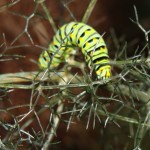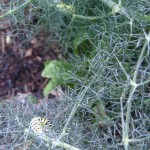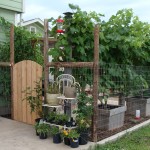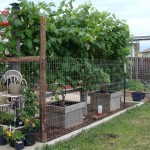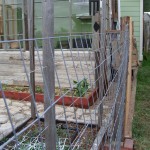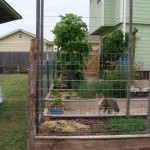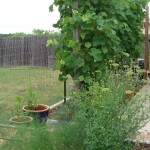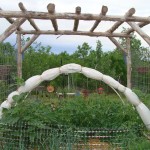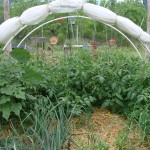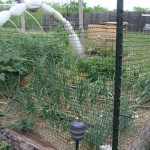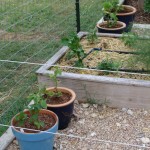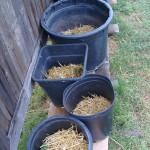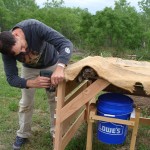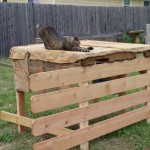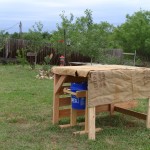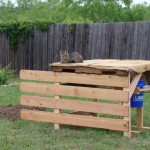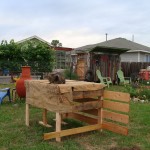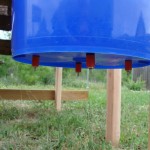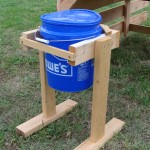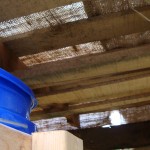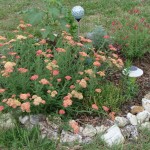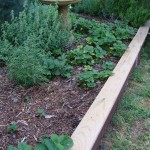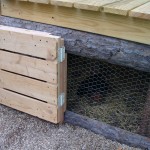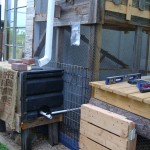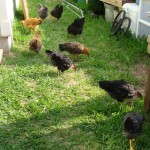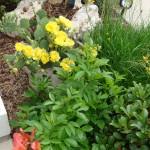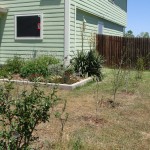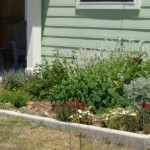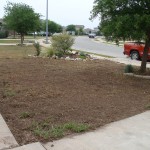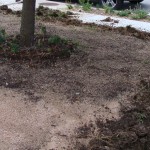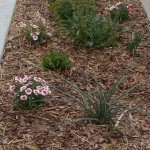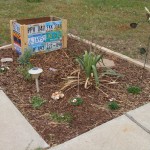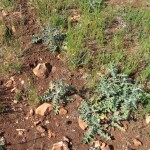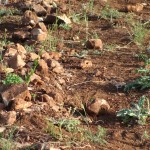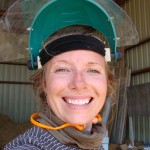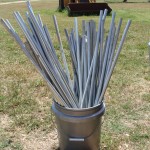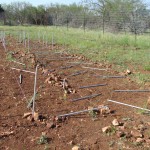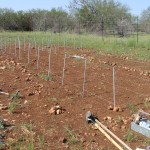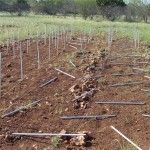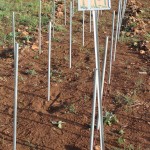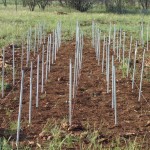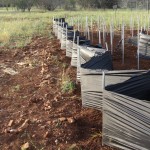May Moments Bring Us Joy
Another Wednesday at the Manor Farmers Market. I met quite a few wonderful people today! I always enjoy engaging conversations with others who are involved in similar projects and experiments at home. We were talking citrus and although I love this fruit dearly, it has been an ongoing challenge of mine to get our Meijer Lemon, Lime, and Tangerine to grow fruitfully in the past. I reluctantly gave up this winter only to find myself getting new varieties this spring and more literature. The fact that I didn’t have a single book on the matter is quite silly since I am immersed in so many others that revolve around food and dirt. My most favorite reads this spring have definitely been carried around with me wherever I go, thinking I’ll have a minute or two.
How to Grow More Vegetables by John Jeavons, which John recommended (Natural Gardener). When I interviewed him in March I asked, if you could suggest one book, what would it be, and that was the one he promoted. I encourage you to get your hands on a copy. It incorporates biointensive growing methods, how many plants and calories you need to feed a certain number of people, and companion planting, ecosystem balance, charts, soil fertility, sustainability,composting, open-pollinated seeds, propagation, seed saving, and of course so much more that I can’t go into detail. You’ll just need to get a copy yourself 🙂 Build that library, put stickers-the ones you get sent to you in the mail with your address on them, in your paper passions and share them with your neighbors and friends who could use to earn a little more. Currently also reading the $64 Tomato.
In that past month we’ve literally transformed our backyard haven with Davin adding gates to the gardens closest to the house to prevent our feathered friends from embarking on beans, peas, eggplant, and grapes. For some reason Davin thought it’d be funny to show them new things they could eat, before he built the fence, which meant flock sitting was necessary.
Our biggest accomplishment of the year in promoting sustainability is from our direct influence and education to our friends and neighbors on the importance of growing your own food, harvesting rainwater, repurposing materials, and alternative methods to grow plants, fruits, and vegetables. Right before we got the April/May issue of Mother Earth(ME) we sent a subscription to our neighbors the Calebs, since they had begun their conquest in transforming their backyard. Once we got that issue in the mail the letter from the Editor of ME asked readers to send a subscription to someone new, I was gleaming with joy knowing that I did this right before they told others to! The stars are aligned. When affordability of growing a garden was brought up, I piped up, “you can’t afford not to!” And thus their journey began. It has been extremely exciting watching them get enthralled in projects that procure Mother Earth. More importantly their children are also learning new skills too! We will be sharing pictures with you and the impressive strides they’ve made since February. The picture displayed is a picture with one of their girls helping Davin with beak trimming. When the Calebs started asking some basic gardening questions I decided they needed more than my blundering mind so I put together a small resource booklet for them of some of the things that were important. I included crop charts for the year, Ag Extension charts on crops that do well in our county, companion planting information, farmer’s almanac info, basic gardening principles for handling drought and intense heat, seed companies to order from and gave them a stack of my Spring seed catalogs from various companies. I also advised them on local gardening centers, online resources and opportunities that might interest them. We’ve also opened up our green library to them which includes books and old issues of Mother Earth News. They sprung forward and have already learned the ever challenging journey that attaining a green thumb isn’t always promising and definitely not easy. They take pride in the fact that they have joined just in time to learn from all of our mistakes. It makes Davin and I chuckle for sure. We have had years of disappointment on growing certain crops here and are always researching this seasons insect challenges. We are very flattered that our methods of living have rubbed off on someone new, especially a family of six! We are thrilled to exchange ideas and lessons learned each week. Gardening humility keeps us humble and surely reminds me of what I’m here for and what my great grandmother taught me.
I got extensions on my two research projects at the University. I hope to finish them in the next month. I still have marketing surveys for seaweed compost and can email you one if you are interested, message me on Facebook or send me a message through our contact form. The sustainable agriculture project on agrivoltaic methods is more like farming in a third world country. I’m learning new skills that I didn’t know I had, including learning how to balance extreme circumstances in the dirt, adversity against all odds, farming in the field alone.
Our spring projects combine different endeavors. Davin’s been keeping busy learning about Hugulkultur, bee collecting, watching countless Wranglerstar youtube videos, searching for Morels in Texas and Missouri, and fishing Trout. He also went to Engineering school for work and has been actively building new projects most every weekend. This past weekend he made a Heat Hut-a place for animals to dwell in the shade in the heat of the sun, three gates, and fenced in our greenhouse chicken coop, outdoor kitchen and shower, grapescape, long garden beds and clothesline lounge.
Some of our updated project pictures are shown.We will try to upload them by projects to our Project section on our site including new pictures of the updated Greenhouse and Chicken Coop that Davin finished in April. Some of the projects you see are my Ag Research Project on Agrivoltaic Systems, Heat Hut, Outdoor Garden Fencing, Spring Landscaping Projects in the front yard, Gardening Methods, Beneficial Insects, Rainwater Drip System, and Free Range Waterer.
#gallery-1 { margin: auto; } #gallery-1 .gallery-item { float: left; margin-top: 10px; text-align: center; width: 33%; } #gallery-1 img { border: 2px solid #cfcfcf; } #gallery-1 .gallery-caption { margin-left: 0; } /* see gallery_shortcode() in wp-includes/media.php */
- Papilio glaucus-Eastern Tiger Swallowtail
- Herbs in the garden designated for beneficial insects
- Davin’s May Project 2014
- Mic fenced in…
- Herbs, Blueberries, and Table Grapes
- Back Gate
- Cover for Tomatoes
- Tomatoes, Onions, Garlic, Peppers, Carrots, Radishes, Beets,
- Pergola Garden Bed May 2014
- Misty, Jubilee, Sweetheart, Sharpblue Blueberries
- Container Gardening with Potatoes
- Davin stapling the burlap down to the frame
- Let your free range animals find shade from the sun!
- Rafe on the new heat hut.
- Make your own free range feeder!
- Easy to move free range water feeder
- From the underside
- Eversweet and Tristar Strawberries
- Herb Garden experiments
- Cedar Hinged Door with lock for easy access.
- Davin created this rainbarrel to collect rain from the Greenhouse coop which runs into the 4 drip feeders inside the coop.
- Dublin, Texas in 2011
- The ladies grazing
- Prickly Pear Cactus, Cana Lily, Esperanza, Thyme, Marjoram, Bulbine
- Transplants and Turf
- Front Garden Bed
- Kristin’s Spring 2014 project: front lawn
- After working soil, still digging…
- Spreading Dirt, KK’s project
- New Front Spring Bed Near Curb March 2014
- New Front Spring Corner Bed April 2014, Kristin’s Project
- Garden Music
- Ground I’m growing in, Kristin’s Project for Sustainable Studies in Graduate School at Texas State University
- More dirty madness
- Sharpening the stakes
- Measure the poles
- Prop up the pole before you cut it
- Cutting the stake
- Bucket of 6 foot stakes
- Sustainable Agriculture Project Spring 2014
- Control and Testing Site
- Test site
- Student Sustainable Farm Side Shade Paneling
- Handpainted repurposed materials.
Has it really been that long?! Catching Up with New Year Recommendations
MISS YOU! As an overachiever by nature, I didn’t realize that my needing to post an update to our blog was so outdated! It’s been on my neverending list of to dos. I actually have piles of topics to discuss as they come up in newspapers, online articles, books, magazines, and networking discussions, and yet they slowly make their way on our site, and in stacks in my art room. As you may have already read, this site is an ongoing project and passion of mine that has developed from my passion for food, gardening and sustainable living. It has become something bigger. Or perhaps I’m branding so keep your eyes open.
WHAT’S BREWING?
We’ve also been brewing a variety of brews. Our, ‘You Gourda Be Kidding Me’ Porter was titled as a contest on facebook, of which my cousin Jake, the beer connoisseur, landed it the special comical title. We made this Porter late fall and used 7 lbs of various squash and pumpkin for the blend. I baked the squash in quarter pieces with the whole spices laid on top. Then we added them throughout the brewing boil in 15 min. increments, in addition to adding 1/3 vanilla bean every 20 min over the course of 1 hour. Our seasonal brew we bottled, and mighty spendy indeed but we were able to produce about 33 bottles of a unique, spicy, sweet, robust medium dark craft beer with a 7.3% ABV. This was also the first recipe that we created and brewed together. Usually I have assisted with the process as minimally as possible but this one was the first batch my husband and I brewed 100% together. We were rather impressed at how well we work together during the process. It went quite a bit smoother than the Friendly Neighbor Brewing nights at home. But we are a good pair in the kitchen too so I’m not surprised. This was also rewarding since their last batch became part of the lost souls of beer explosions. And a whole batch was ruined from excessive carbonation which could have been caused from fluctuating temperature changes where they were stored, apparently a common mishap for Texas according to AHS(Austin Homebrew Supply). We have a Honey Kolsch on tap that should be ready by next weekend. I got Davin an awesome thermal growler with my dividend check from REI for Christmas. Great way to give a green gift! It’s insulated and will keep beverages hot/cold for at least 24 hrs it says.
GREEN GARAGE SALE? REI-buy a lifetime membership for $20, get great deals and a dividend check of 10% back from your purchases throughout the year to spend at REI on anything you want. Another green way to take advantage of REI, check out their free programs, classes offered, and volunteering opportunities in your location. Also great company with wonderful benefits to work in a healthy and fun environment. One of our favorite REI regular events includes their garage sales, great deals on returned items from customers; shoes, bags, watches, bikes, racks, etc. Check different store locations to find out when their garage sales are happening. We’ve attended one in Portland, Oregon and several in Austin, Texas that had fantastic deals!
COMPOST TEA YOU SAY?
Since the fall I have also attended an invaluable Compost Tea Class at Third Coast Horticulture Supply in Austin that offered alternative methods of gardening by moderating garden techniques by monitoring, analyzing, and hosting the ideal amounts of fungus and bacteria within our backyard ecosystem. The perfect balance of the two prevents disease, pests, freezing, and heat stress among other things and also allows the plants to be incredibly resilient, strong, and much more efficient in their production abilities. No need to feed plants on a regular basis with various plant foods when the growing medium is in complete harmony by the perfect balance of bacteria and fungus, the system feeds itself. Creating compost tea can be done a number of ways but with proper aeration(using a pump) in a five gallon bucket and a fine mesh cloth, a tea can be made while mixing medium materials and soaking them in water. There are several different formulas that one can use to create their own compost tea and you can also buy the product already made and ready to use. One may also take the compost tea mixture and apply it in undiluted measurements like an extract which can have a larger impact on the overall effect, especially on a commercial farm scale.
How to make compost tea? Yes, more on this later. If I can upload documents then I will upload the free pamphlet we received at the class titled, ‘Soil Simplified: An Introduction to Your Garden’s Microbial Life.’ The definition of Compost Tea in this piece of literature states, “Compost tea is a brew of oxygen rich water, high quality compost, and some foods to help microbes bloom in population. ” The article goes onto discuss the goal of a good tea is to “substantially increase the amount of beneficial organisms. ” Compost Tea(CT) may then be used to coat leaf surfaces, inoculate compost, and restore and improve soil health through a bio-film protection barrier that keeps pathogens from feeding on the plant. “The microbes also respire CO2 that helps fuel the plants metabolism and through usage of tea in compost or soil the biomass of healthy life is stored and converts into energy. As you may already know compost is already organic matter that has broken down over time by microbes and may be used as food aka energy, later. Adding compost to your garden adds diversity to your soil and compost varieties vary by different compositions used; essentially compost is composed of sunlight, water, oxygen, nitrogen-green and brown earth matter(leafy plants,greens, grass, etc. for green, and wood, leaves, paper, etc. for brown-just a few examples).Many people use mushroom compost-obviously excellent for contributing a mycorrhizal relationship with fungi symbiosis. Some use chicken manure, and cow manure, but a good rule of thumb is to know EXACTLY WHERE YOUR COMPOST MATERIALS CAME FROM if you don’t make your own. A lot of people are easily mislead by garden products that are labeled as “Organic” because they don’t understand the science of the matter at hand, for instance, Miracle Grow-Scott’s, Monsanto product, advertises, “Organic Gardening Soil”-well duh, anything living is organic-here’s the definition I referenced from biology-online.org below but don’t believe what you see if you haven’t done the research yourself. Miracle Grow-Scott’s-Monsanto, the bain of our existence globally, and is far from toting the organic emblem of health. Just because your dirt says it’s organic, doesn’t mean that it’s nontoxic, chemical-free, etc. Do your homework, I’m just scraping the surface of the subject. Research your seeds, your plants you buy at the store, seed-starts, etc. GMO vs. Non GMO to help get your head in the game. Mother Earth News is a great online resource, digital publication, or magazine to subscribe to if you’re a newbie and want to put forth more effort in transforming your garden, home, lawn, life, food sources, and lifestyle. Also, the LIBRARY, I must reference it again, next to online used books and swaping good resources with your friends.
Word origin: Latin organicus, Greek organikós, órgan(on).
Related forms: organically (adverb)
Organic~Definition: noun, plural: organics(Chemistry) An organic compound; or any substance containing carbon-based compounds, especially produced by or derived from living organisms.(Agriculture) An organic food; or any food that is organically grown (i.e. grown without using or applying synthetic pesticides, fungicides, inorganic fertilizers, or preservatives. Adjective(biology) Of, pertaining to, derived from, or similar to an organ of the body. http://www.biology-online.org/dictionary/Organic
Inorganic~Definition:adjective(1) Of or pertaining to substances that are not of organic origin.(2) Relating to a substance that does not contain carbon.(3) Of mineral, rather than of biological, origin. http://www.biology-online.org/dictionary/Inorganic
THAT’S RIGHT, CHEMICAL FREE 2014-I know you wanted to accomplish that goal this year! :}
Furthermore, funny thing is, once you get into the matter of what’s in your dirt, where your dirt came from, what dirt your food grew from, what the dirt and plants were sprayed with to keep things growing, it’ll make you sick to your stomach so just make sure to do your research if you are really interested in becoming an “Organic Gardener.” In order to slap on the label you need at least 7 years of chemical free gardening under your belt on your land in addition to all the other legislative hoops you must jump through the FDA and USDA for Organic certification. You can do just as good of a job as a chemical free, “organic” gardener by making sure that everything that goes onto your lawn, garden beds, water, etc. is eco-friendly, non-toxic, and natural based. That’s right, no more crap sprayed on your garden beds AND LAWN that kills fish, birds, livestock, children, pets, and adults-don’t worry, there’s enough studies to prove that, it does make a difference. Just because you don’t feed your edible plants and herbs toxins doesn’t mean they won’t get what you sprayed or fertilized your grass with, NOT Dillo dirt(Travis county human waste with pharmaceuticals in it)-Organics By Gosh sells this misleading product too, ironic, don’t ya think? NOT Roundup-our poor ecosystem! NOTHING TOXIC ON YOUR HOMESTEAD PERIOD, EVER! Did I sound a bit concerned on the topic? Do you really want that in your drinking water? Didn’t think so, oh, well, it definitely depends on where you live but heads up folks if you’re in Austin, part of your water may come from the Colorado River, and guess where those tire rims, styraphome and non recycled water bottles, and kid toys go to die-in the lakes, streams, rivers, and oceans, if not in landfills, and natural habitats already. If it’s not petrolium based ingredients in your body, home and garden products,then it’s chemicals that you don’t know how to pronounce, and toxins that you don’t want in your body or the environment that you live in. Do ya think our ancestors had all that garbage hundreds of years ago to live sustainably? Heck no, did they survive, hell yeah they did. And without all the pills to boot, don’t even get me started, jk. Get over the illusion that chemicals are not bad for you and you’ll be a lot better off. Promise. Trust the millions of people who have died on behalf of the multitude of discussions that have spawned on behalf of our exposure to man made ingredients, not derived from plants. There are always other options before using chemical agents that can end your life or blind you. Many of you already know what I’m loosely and somewhat lightly babbling about, those of you who are wanting to learn more? Get your hands on some documentaries via Netflix, library, or search for them for free online. Some titles of films to watch that might surprise you, not in any order, ‘Corn, Death on a Factory Farm, Food Inc., Dirt. The Movie, Supersize Me which I’ve mentioned before…The Cove, there’s a bunch that are easily accessible on YouTube for free too. Here’s a quick link to some reviews from about.com http://documentaries.about.com/od/populardocsubjects/tp/Food_and_Nutrition_Docu.htm
On a positive note, I’d like to end my post with some uplifting insight and more positive information since I didn’t foresee myself going on a last minute rampage. Also in the mean time, start your own research on ways to improve your garden and visit Third Coast Horticulture Supplies in Austin, Texas! There’s also one in Muskegon, Michigan but I’m not sure if they know each other or not. The owner Shawn is a walking encyclopedia in the field and will show you how to test your samples under a microscope.
Other Must Reads for the NEW YEAR 2014!
A good start and a good read to help you grasp the concept of Compost Tea in it’s entirety? Pick up a copy of Teaming with Microbes The Organic Gardener’s Guide to the Soil Food Web Revised Edition by Jeff Lowenfels & Wayne Lewis and check out their website.
Sleeping Naked is Green by Vanessa Farquharson-got this awesome find at Half Price Books for $4 and it’s a gem of knowledge. Even a bit ahead of herself at the time, this Canadian writer vowed to green up her life in 366 days and wrote about it. Great ideas, and comical events took place in her book and is a must read for autobiography, sustainable, earth lovers, and those wanting some new green ideas, published in 2009. A lot of wonderful references, and ideas for you to take as you embark upon your new year goals, or help you make some if you haven’t already.
Texas Bug Book by Garrett & Beck, yes, we often wonder what strange new insect has come to taunt us throughout the growing season, this one is pretty handy to have by your side. Got ours used at Half Price Books, but also Amazon has used copies for sale.
Beauty By Nature by Brigitte Mars-make natural products for you and your home from herbs you can grow in your garden. This is a gem of a find. Easy to follow, read, and use.
GAIA’s GARDEN by Toby Hemenway-If you are looking for your foothold in the permaculture world this is the perfect book to get your feet wet and dirty.
Texas Mushrooms by Metzler, Metzler, and Miller-this is almost $30 or so, but if you are a mushroom forager in Texas, get yourself a copy. Also the National Audubon Society Field Guide to North American Mushrooms is a great handbook too.
Storey’s Guide to Raising Chickens by Gail Damerow-How to care, feeding, housing, health, this book covers a lot of different topics that relate to your flock, so I was pleased when I was choosing, one book to buy. Again, there is countless info online,and in magazines but we’ve been pleased with this reference.
Texas Home Landscaping including Oklahoma by Greg Grant and Roger Holmes, includes drought tolerant plants, and natives, etc. They have a series that includes Cali, Mid-Atlantic, Midwest, Northeast, Northwest, and Southeast. Some of which include parts of Canada and British Columbia.
I like the local Agri-chapter free color publication of native plant species for Travis County available for more useful native plant selections, and non-native plant options that do well in the area. The last one they published was in 2009 I believe. Local Garden Centers in and around Austin still have copies available. Check out this link http://travis-tx.tamu.edu/agriculture-natural-resources/.
Good luck to you on your journey this year! May you encounter invigorating new moments to shine and be inspired. As I continue to study in the Graduate program at Texas State with my Interdisciplinary Studies in Sustainability I will keep you posted. I will start adding more information to the different site topics too. Gardening and Food recipes will be of focus in the beginning of the year. Cheers, and straight ahead!
